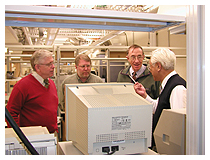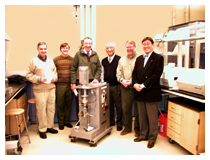Today's Notables
MIT Visit Report (Part 2)
April 2003
Hisashi Furuichi
President and C.E.O.
When I entered the laboratory at MIT, the TK Filmics sent previously from Japan had been unpacked, as though patiently waiting for Mr. Asa, the inventor. Near the Filmics was a Microtracs particle size analysis. Anyway, it looked as though all systems were ready to go with wiring and water lines hooked up. The lab assistant was well prepared; he even got connectors with diameter in centimeters and all of the other parts necessary to make the adjustment from equipment there previously. Usually, it is those small details that end up taking the most time so I was surprised to see such thorough preparation. A Microtracs person was also on hand to make the proper settings on the particle size analysis. Everything was set up and ready by the end of the morning.

Professor Dalzell belongs to the chemical engineering faculty having a class of experiments and is in charge of determining the content of the 3-month-long term project. This term, the project was to determine the fluid dispersion principle behind the Filmics and to clarify the most effective uses. Dr. Dalzell became enthusiastic about this project due to the book that Mr. Asa wrote, Dispersion Technology in the 21st Century, which was translated to English. Dr. Dalzell read the book and became interested in our proposal to do this project. After lunch, we were introduced to the project team members. Besides Dr. Dalzell, there is Professor Colton who was to oversee and advise the research team. There is one teaching assistance and 3 students, for a total of 6 people. Professor Colton also has quite an impressive background and more than 100 articles published under his name.

After introductions, we proceeded with a demonstration using material
we brought from Japan. Mr. Asa explained the mixing system and the
dispersion effect. Both professors had many questions for Mr. Asa.
Finally Professor Colton said that if what Mr. Asa had explained
could be theoretically proven, he had made quite a revolutionary
discovery. After the demonstration, a professor from the biotechnology
lab came in and asked if he could also use Filmics. Of course, we
were pleased that MIT labs were interested in the machine. Unlike
Japanese universities, there is little division among professors.
He just walked in, curious about whatever was going on. Mr. Asa
and I just sat back and listened to the conversation. My impression
was that if it were not for that type of free environment, there
would be little chance for creative thought, inventiveness and discovery.
The project team will keep us up-to-date periodically on the methodology
of the project. We left MIT with the excitement of high expectations
for positive outcome
HOME > What’s New > Today's Notables > Details














